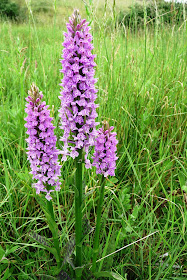Found in a dogs watering bowl outside the VC this morning. This is the 2nd one I've on the patch and photos showing its smart underside can be seen here.
Pages
▼
Wednesday, 29 June 2016
Tuesday, 28 June 2016
Sunday, 26 June 2016
Friday, 24 June 2016
Mullein Moth caterpillars
I came across these two Mullein Moth Cucullia verbasci caterpillars feeding on Water Figwort plants in The Paddocks ditch. It looked like they had both started eating at the top of a plant and had just kept munching away. A very distinctive caterpillar which signals to predators that it is not nice to eat!
Insects and spiders on Wild Parsnip
The Wild Parsnip Pastinaca sativa flowers at Holme Dunes yesterday were smothered in feeding insects, and a couple of spiders hunting them. At present I do not have the necessary books or knowledge to ID them all and so here are a few for you to name for me!
Thanks to James Emerson again for rapid IDs.
A Hover-fly Chrysotoxum bicinctum
Noon Fly Mesembrina meridiana
Is this a species of Bupestrid beetle? Possibly Chequered Click Beetle Prosternon tessellatum
Two of these spiders were hunting on one of the plants. I think they could be Large-jawed Orb Web Spiders Tetragnatha montana.
Thanks to James Emerson again for rapid IDs.
A Hover-fly Chrysotoxum bicinctum
Noon Fly Mesembrina meridiana
Is this a species of Bupestrid beetle? Possibly Chequered Click Beetle Prosternon tessellatum
Two of these spiders were hunting on one of the plants. I think they could be Large-jawed Orb Web Spiders Tetragnatha montana.
An orchid hybrid
Many orchid hybrids have been recorded in Britain. This is one I found at Holme Dunes yesterday. It is Common Spotted-orchid Dactylorhiza fuchsia x Southern Marsh-orchid Dactylorhiza praetermissa. Those with prominent ring spots on their leaves are sometimes known as Leopard Marsh-orchids. Most hybrid plants, like this one, are very robust specimens.
Tuesday, 21 June 2016
A beetle and a fly to be identified!
Someone, somewhere, will probably be able to identify these two insects I saw today!
Thanks to James Emerson for a very prompt ID of both.
A beetle on a Yellow Flag flower behind the dunes at Old Hunstanton.
A Garden Chafer Phyllopertha horticola with an almost black thorax.
A pair of flies on a bramble flower at Ringstead Downs.
A Thick-headed Fly Sicus ferrugineus - an endoparasite of bumble bees
Thanks to James Emerson for a very prompt ID of both.
A beetle on a Yellow Flag flower behind the dunes at Old Hunstanton.
A Garden Chafer Phyllopertha horticola with an almost black thorax.
A pair of flies on a bramble flower at Ringstead Downs.
A Thick-headed Fly Sicus ferrugineus - an endoparasite of bumble bees
Monday, 20 June 2016
A damsel, a crane and a butter - fly
A female Blue-tailed Damselfly Ischnura elegans at Holme Marsh. The females occur in five colour forms, this one is rufescens-obsoleta.
A female Common Blue Polyommatus Icarus at Holme Dunes
A pair of Spotted Crane-flies Nephrotoma appendiculata at Ringstead Downs
A female Common Blue Polyommatus Icarus at Holme Dunes
A pair of Spotted Crane-flies Nephrotoma appendiculata at Ringstead Downs
A few flowers
Just a few of the plants currently in flower at Holme Dunes and Ringstead Downs.
Early Marsh-orchid Dactylorhiza incarnata
Pyramidal Orchid Anacamptis pyramidalis
Sweet Vernal-grass Anthoxanthum odoratum
Sea Plantain Plantago maritima
Early Marsh-orchid Dactylorhiza incarnata
Pyramidal Orchid Anacamptis pyramidalis
Bee Orchid Ophrys apifera
Dropwort Filipendula vulgaris
Sweet Vernal-grass Anthoxanthum odoratum
Sea Arrowgrass Triglochin maritima
Sea Plantain Plantago maritima
Saturday, 18 June 2016
A bumblebee mimic: the hoverfly Volucella bombylans
Volucella bombylans, Ringstead Downs, 5th June 2016
Marmalade Hoverfly
The Marmalade Hoverfly, Episyrphus balteatus Holme Marsh 18th June 2016: a very common hoverfly, on the wing for much of the year.
Monday, 13 June 2016
Box Bug
We swept this Box Bug Gonocerus acuteangulatus today from the dunes at Old Hunstanton. It is only the second individual we have found on the patch, the last being along the Holmhurst Track on 8th December 2014, this being the first record for Norfolk.
Closterotomus trivialis
We swept several individuals of this Mirid bug off Japanese Rose in the dunes today at Old Hunstanton. The species was first recorded in Britain in 2008 and has spread rapidly. That said, this may be the first record for Norfolk. 22.06.2016....It is a first for Norfolk !
Currant Clearwing
A pheromone lure attracted 4 or 5 of these smart moths within seconds of deployment at lunchtime today.
Sunday, 5 June 2016
Scorpion Fly at Ringstead Downs
Panorpis germanica (confirmed by examination of genital capsule), Ringstead Downs, 5th June 2016
This and Panorpis germanica were numerous in the Downs today and both species were also present at Holme on 5th June.
This and Panorpis germanica were numerous in the Downs today and both species were also present at Holme on 5th June.
Narrow-bordered five-spot burnet moths at Holme
'Five-spot' burnets are usually numerous in late spring at the west end of Holme NWT and have long been assumed, on adult patterning, to be narrow-bordered. Identifications based on adult patterning are no longer considered safe, so we searched for many hours in 2015 to find caterpillars, which are very distinctive, but found neither larvae nor adults ! A five minute search this morning revealed 3 full-grown larvae and 5 pupal cases. The caterpillars were on Meadow Vetchling, the foodplant of this species (5 spot burnets eat Bird-foot Trefoil) and the pupal cases were at the top of rushes (5 spots apparently place their very low in the vegetation and are much more difficult to find).
The adult was photographed on 21st June 2014 (presumed to be this species); larvae and pupal cases found today, 5th June 2016














































